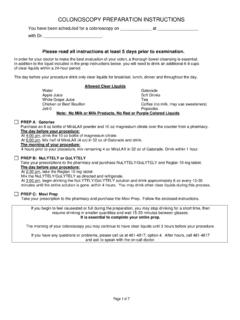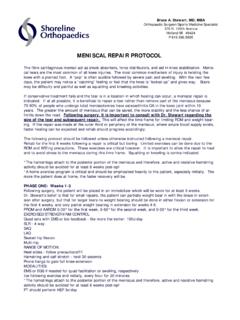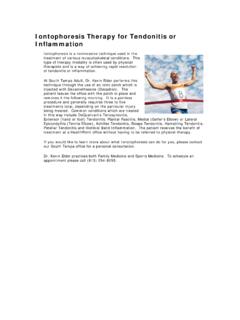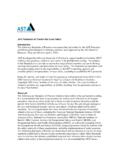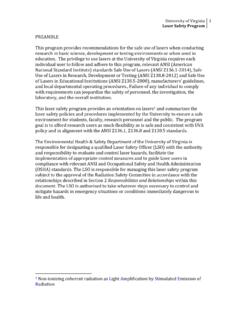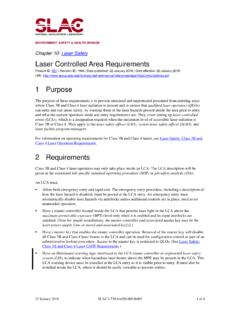Transcription of BRANCH RETINAL VEIN OCCLUSION (BRVO) AND …
1 1 BRANCH RETINAL VEIN OCCLUSION (BRVO) AND laser TREATMENT INTRODUCTION: BRANCH RETINAL Vein OCCLUSION (BRVO) involves the obstruction of a major venous blood vessel which prevents adequate drainage of blood from the eye. As a result, blood and fluid collect on the retina particularly at the reading center, thus leading to central visual loss. Prolonged blockage of the venous blood vessel may be associated with insufficient blood flow to certain areas resulting in the occurrence of abnormal vascular growths. These vascular growths can bleed into the vitreous cavity causing marked visual loss. BRVO may be a totally independent condition. However, the following conditions have been found to have an association with BRVO hypertension (high blood pressure), circulatory abnormalities, and certain patients with diabetes.
2 TREATMENT: A. Focal laser -After macular edema (collection of fluid at the reading center) develops due to BRVO, it may spontaneously absorb when collaterals (alternate drainage vessels) develop. The BRANCH RETINAL Vein OCCLUSION Study (BRVOS) definitively established the benefit of laser treatment for those eyes with visual acuity of 20/40 or worse, associated with BRVO. Treated eyes had an average visual acuity of 20/40 while untreated eyes had an average visual acuity of 20/70. 65% of the treated eyes gained 2 or more lines from baseline vs only 37% of the untreated eyes in 2 consecutive visits. Focal laser is performed in a grid-like pattern around the reading center. The laser light is focused on the retina by way of a temporary contact lens. I. What treatment can do: Focal laser can increase the chance of improvement or stabilization of vision.
3 If visual improvement occurs, it takes place gradually. II. What treatment cannot do: Focal laser does not guarantee improvement or stabilization of vision in every case. Some eyes will continue to deteriorate in spite of treatment. 2 III. Risks and Complications a. Common: 1. Gray spots around the center in a grid pattern (usually temporary). 2. Temporary glare and sensitivity to light 3. Minor irritation b. Uncommon: 1. Hemorrhage 2. RETINAL hole(s) formation 3. Inflammatory reaction 4. Visual deterioration (rare) c. Other potential risks/complications not listed may be discussed with you by the doctor. IV. Alternatives: Observation only. No other surgical or medical therapy is available. V. Post-Operative Course: Usually no restriction or medication is necessary.
4 A follow-up appointment is given. If retrobulbar injection is used, the eye is patched with ointment for at least 6-12 hours. B. Scattered laser Treatment: When abnormal vascular growth develops, severe bleeding can lead to marked visual loss. Scattered laser (SL) treatment has been found to be beneficial. A large number of laser lesions are delivered through a temporary contact lens on multiple areas of the retina. The treatment potentially arrests the progress of the vascular growth, thus indirectly leads to visual improvement of stabilization. The treatment is usually much less extensive than panretinal photocoagulation in diabetic retinopathy. I. What treatment can do: Focal laser can increase the chance of improvement or stabilization of vision. If visual improvement occurs, it takes place gradually.
5 II. What treatment cannot do: Focal laser does NOT directly improve the status of the reading center, nor does it guarantee improvement or stabilization of vision in every case. In spite of treatment, some eyes will continue to deteriorate. 3 III. Risks and Complications Common 1. Glare and sensitivity to light. 2. Minor irritation. 3. Temporary inflammatory reaction. Risks and Complications Uncommon 1. Decreased peripheral visual field. 2. Decreased ability to adapt to the dark. 3. Decreased central vision. 4. RETINAL hole(s) formation. 5. Hemorrhage. 6. RETINAL detachment (rare); Separation of the retina from its normal position. 7. Increased cataract (clouding of the lens). 8. Acute glaucoma (acute rise in intraocular pressure). Other potential complications and risks not listed here may be discussed by the doctor.
6 IV. Alternatives: Peripheral cryotherapy is performed on a less frequent basis than scattered laser treatment. V. Post-treatment course: Usually minimal restriction is necessary. Special steroid eye drops are prescribed temporarily. If blood is present, specific body positioning may be necessary. If retrobulbar injection has been used for anesthesia, patching with eye ointment for 6-12 hours is necessary. 4 PROCEDURE NOTE PATIENT: _____SS# _____ DATE: _____ SURGEON: DR. ERIC MANN PROCEDURE: Focal/Grid laser , _____ INDICATIONS:_____ VA: OD _____ OS _____ INFORMED CONSENT: All the risks, benefits, alternatives and intent of laser treatment with anesthesia were presented to the patient in an extensive discussion and in written form(s) _____.
7 The patient understood that laser treatment is performed not to improve vision, but to hopefully stabilize vision and prevent further visual loss. The patient stated that he/she had a good understanding of his/her clinical situation, including the specific ocular and anesthetic risks (loss of vision, need for further surgery, and rarely, loss of globe) and consented to laser treatment. TREATMENT: Under topical anesthesia Under retrobulbar anesthesia: with the patient supine and fixating straight ahead, 3 cc of 2% lidocaine were injected into the retrobulbar space, using a #25 guage needle and a 10 cc syringe. Adequate anesthesia and akinesia were obtained. Following treatment, the eye was patched for 24 hours. Under fluorescein guidance with a _____ lens and the argon green laser , focal laser treatment of leaking microaneurysms were performed to whiten the aneurysms.
8 Grid laser treatment was performed with grade 1 intensity burns, one spot width apart in areas of diffuse capillary leakage with corresponding RETINAL thickening. laser parameters and pattern (sparing 500 microns from fixation) are below. laser treatment was performed without complication. The patient tolerated the procedure well and left the laser suite in good condition. Post-operative photographs were requested. PARAMETERS: , 100-microns, _____mW, & _____total spots. POST-OPERATIVE CARE & MANAGEMENT: The patient was instructed to return in follow-up _____ or immediately upon any decreased vision, pain, or symptoms of RD or RB (which were reviewed). Specific post-operative instructions included HOB elevated and restricted activities with no physical exertion. The need for diabetic control and the results of the DCCT were reviewed.
9 5 RECEIPT OF POST-OP INSTRUCTIONS I _____ have been given postoperative instruction information. I have had the opportunity to read, understand and ask questions regarding my planned surgical procedure(s). Dr. Mann has explained this procedure to me in depth. I have been informed in regard to the potential benefits, complications, risk and alternatives of the procedure. Sufficient time was allowed for me to ask questions and these questions were answered to my satisfaction. _____ _____ Patient signature Date _____ _____ Witness signature Date 6 PERIBULBAR & RETROBULBAR ANESTHESIA Absence of pain (anesthesia) and immobilization of the eye (akinesia) are often necessary to allow effective laser and cryotherapy treatment or intraocular surgery.
10 Both anesthesia and akinesia can be obtained to a variable degree by injection of anesthetic (Lidocaine and/or Marcaine) around and behind the eyeball prior to treatment or surgery. The following are common effects of the anesthetic injection but are usually temporary: 1. Blurring of vision 2. Numbness and swelling around the eye 3. Ptosis (drooping of the eyelid) 4. Diplopia (double vision) The following are uncommon complications of the anesthetic injection: 1. Retrobulbar or periorbital hemorrhage (bleeding behind or around the eyeball) 2. Globe perforation (puncture of the eyeball by the needle used for anesthetic injection) 3. Optic nerve injury or vascular damage (central RETINAL artery or vein OCCLUSION ) 4. Allergic reaction to the anesthetic 5. Seizure 6. Cardiorespiratory arrest (death) 7.
